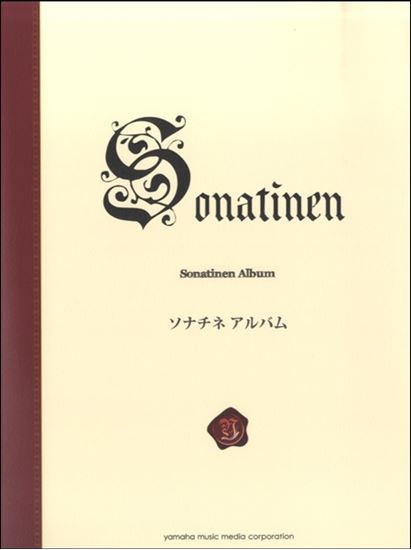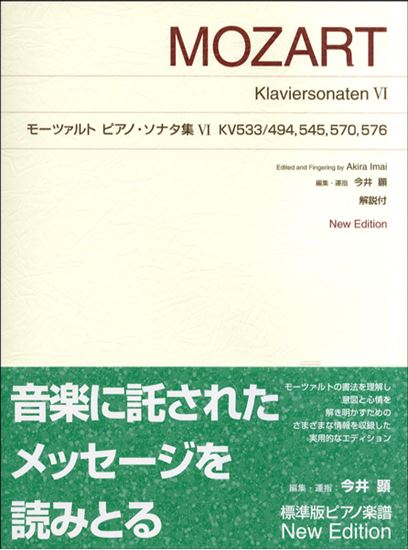Mozart, Wolfgang Amadeus : Sonate für Klavier Nr.15 C-Dur K.545
Work Overview
Publication Year:1805
First Publisher:Bureau d'arts et d'industrie
Instrumentation:Piano Solo
Genre:sonata
Total Playing Time:10 min 00 sec
Copyright:Public Domain
Additional Notes:新モーツァルト全集では、ソナタ番号が旧来の「15番」から「16番」へと変更された。
Commentary (1)
Author : Okada, Akihiro
Last Updated: December 1, 2009
[Open]
Author : Okada, Akihiro
Mozart's own "Catalogue of All My Works" bears the date June 26, 1788, and is inscribed "A Little Clavier Sonata for Beginners." Among the clavier sonatas composed during his Vienna period, none have a clear compositional history. From the title in the "Catalogue of All My Works," it is presumed that this sonata was likely written for a pupil or commissioned as a piece for lessons, but the circumstances of its inception remain unknown.
That this sonata is still widely popular today as a piano lesson material is understandable, not only because of the composer's "for beginners" inscription but also due to its simple melodies and compactly structured form.
First Movement: C Major, 4/4 time, Sonata Form
Above an Alberti bass, the principal theme, a simple melody without double stops, is presented. Following a transition via scale passages (m. 5–), a similarly simple secondary theme appears in the dominant key of G major (m. 14–). After a transition with arpeggiated chords (m. 18–), the first half concludes with a short coda.
The second half (m. 29–) begins with the principal theme in G minor, the parallel minor of the dominant, and immediately modulates to D minor. Then, through scale passages, it progresses from A minor to F major.
The principal theme is recapitulated in F major, the subdominant of the tonic (m. 42–), and the transitional section with scale passages is expanded (m. 46–).
This recapitulation of the principal theme in the subdominant is often noted as peculiar, but it is by no means rare for sonata form, which originally developed from binary form. While indeed there are no other examples in Mozart's other clavier sonatas, recapitulations in the subdominant are found in older types of sonatas, and examples can also be seen in Schubert's sonatas.
More importantly, this modulation to the subdominant is considered intentional rather than inevitable. This is because the key immediately preceding the theme's recapitulation is A minor, and a modulation to C major (the tonic), its parallel major, could have been achieved naturally.
Furthermore, although the expansion of the transitional section with scale passages leads the key from F major to C major, it ultimately cadences on the dominant chord, just as in the exposition, giving the recapitulation of the secondary theme an abrupt impression (to aim for a natural recapitulation, it would need to cadence on the tonic chord of C major). If so, then the expansion of these scale passages might indeed have been intentional, and, referring back to the title "for beginners," it might have deliberately incorporated scale exercises for both hands.
Subsequently, the secondary theme is recapitulated in the tonic (m. 59–), and after a transition with arpeggiated chords, the movement concludes with a coda similar to the first half.
Second Movement: G Major, 3/4 time
An Andante slow movement. The melody is played over an Alberti bass throughout. The melody incorporates figures such as scales and arpeggios, along with contrasting articulations like legato and staccato. While such expressive melodies are not uncommon in Mozart's works, it can be argued that these elements were used intentionally.
The movement consists of three sections. The first and second sections are each repeated by repeat signs, while the third section has approximately twice the number of measures as the first two sections combined, suggesting it can be interpreted as a large Bar form.
In the first section, an 8-measure theme and its variation are presented. The second section (m. 17–) begins in the dominant and repeats the latter half of the first section in the tonic, forming a concise binary form.
The third section (m. 33–) begins in the parallel minor, G minor, and the theme is varied. After passing through B-flat major and C minor, it returns to G minor but quickly modulates to G major to recapitulate the theme (m. 49–). Finally, the movement concludes via the subdominant, C major.
Third Movement: C Major, 2/4 time, Rondo Form
The rondo theme is characterized by a motive where the lower voice imitates the upper voice, which descends by a third in double thirds. These "double thirds" are used throughout the movement and are considered a learning objective for this movement. The motive of double thirds from the rondo theme appears in the couplet theme in the dominant G major, and in the middle section which modulates to the parallel minor A minor.
As analyzed above, from the perspective of a learning piece, it is evident that this sonata is structured such that each movement presents specific learning objectives, allowing them to be thoroughly assimilated.
Movements (3)
Arrangements & Related Works(4) <Show>
Fujii, Eiichi: Piano Sonata No.15 (arr. Fujii, Eiichi)
Total Performance Time: 2 min 30 sec
Aki, Tohru: Sonate für Klavier Nr.15 K.545 C-Dur
Key: C-Dur
Goto, Makoto: ピアノ・ソナタ K.545より(原曲:モーツァルト/王様のピアノ)
Total Performance Time: 3 min 50 sec
PTNA & Partner Channel Videos(22items) View More
Sheet MusicView More
Scores List (51)

(株)音楽之友社

カワイ出版

(株)全音楽譜出版社

(株)全音楽譜出版社

(株)ヤマハミュージックエンタテインメントホールディングス

(株)全音楽譜出版社

(株)春秋社

(株)全音楽譜出版社

(株)全音楽譜出版社

(株)リットーミュージック

ミュージックランド

ミュージックランド

(株)全音楽譜出版社

KMP(ケイ・エム・ピー) ケイエムピー

KMP(ケイ・エム・ピー) ケイエムピー

(株)リットーミュージック

(株)オンキョウパブリッシュ〇

(株)共同音楽出版社

ミュージックランド

(株)ヤマハミュージックエンタテインメントホールディングス

ミュージックランド

(株)ドレミ楽譜出版社

(株)全音楽譜出版社

(株)ドレミ楽譜出版社

(株)全音楽譜出版社

(株)ドレミ楽譜出版社

(株)音楽之友社

(株)ドレミ楽譜出版社

ロケットミュージック

(株)全音楽譜出版社

(株)ヤマハミュージックエンタテインメントホールディングス

(株)ドレミ楽譜出版社

(株)ヤマハミュージックエンタテインメントホールディングス

(株)全音楽譜出版社

(株)音楽之友社

(株)東音企画(バスティン)

(株)ヤマハミュージックエンタテインメントホールディングス

(株)音楽之友社

(株)音楽之友社

(株)学研プラス

(株)全音楽譜出版社

Neil A. Kjos Music Company

Neil A. Kjos Music Company

ミュッセ























